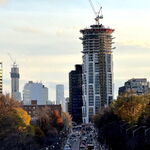steveintoronto
Superstar
This will crop up in the news again, doubtless, baseless or not, but one has to wonder how that Flexity derailed so readily:
Which begs the question: Is the track on King where it crosses University (a very high wear location) up to spec?
Addendum:
https://www.theglobeandmail.com/new...isqualified-streetcar-as-safe/article1058246/JEFF GRAY QUEEN'S PARK REPORTER Globe and Mail
TORONTO
PUBLISHED JULY 25, 2008 UPDATED APRIL 27, 2018
[...]
Bombardier sources said the firm was blindsided by the TTC's announcement last week that its streetcar design had flunked a technical test of how it would handle the city's tight turns and steep hills, and by accusations from TTC chairman Adam Giambrone that Bombardier had knowingly submitted a failing bid.
[...]
The TTC had said the company submitted its computer modelling on how the streetcar would handle Toronto's tracks using parameters other than those provided by the commission. Bombardier sources yesterday said they did so because the TTC explicitly asked bidders to do that.
According to the Bombardier sources, who spoke to The Globe and Mail on condition of anonymity, the dispute centres on a two-degree difference in the angle of the top of the rail underneath the company's low-floor streetcar's wheels.
The TTC, mindful that tracks can be worn down, asked bidders to model their vehicles with a 70-degree angle. Bombardier's vehicle "did not perform optimally" under this condition, company sources acknowledged. But the sources said the TTC had asked bidders to include "alternative parameters" to show how they believe their car would best perform.
Bombardier did so, suggesting a car designed for a 72-degree wheel-track interface that the company says would work on all but a tiny fraction of the TTC's tracks, which are in the process of being replaced.[...]
Which begs the question: Is the track on King where it crosses University (a very high wear location) up to spec?
Addendum:
https://www.toronto.ca/legdocs/mmis/2019/cc/bgrd/backgroundfile-132032.pdfFurthermore, the TTC tentatively plans on rehabilitating streetcar track on King Street between Dufferin Street and Parliament Street in stages through 2023;




